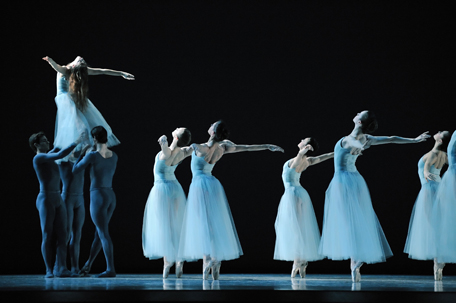
The mystery of blue
When the curtain opens on the San Francisco Ballet’s program of “Balanchine’s Masterpieces,” the audience beholds a field of ballerinas in long dresses of semitransparent tulle, not quite as full as the long tutus of Romantic ballet but reminiscent of that world of ethereal, inhuman creatures—sylphs, or the ghosts of women who have died on their wedding nights, or girls who have been transformed into swans.
Standing feet together, the dancers’ right arms are posed in a diagonal toward the left-hand side of the balconies. There are no sets, only a flush of blue across the scrim at the back of the stage and across the pale blue of the dancer’s dresses. The inhabitants of “Serenade,” which premiered professionally in 1935 at the American Ballet in New York, are a vision. And the ballet, visionary, for as much as it resembles a dream of the late 19th century, there are moments within the ballet that are small revelations—not only of Balanchine’s imagination but also of the directions that ballet would take toward an abstract form of dance that nonetheless conveys a narrative of emotion and resolution.
First among these revelations is the position of the right hand at the opening of the ballet: rather than the expected long line stretching through the arm to the tips of the fingers, the hand is broken at the wrist like a gesture of pushing back, but rather than reading that as a mutiny from the predictable, the pose seems gently surprised, as if the dancers were transfixed by some distant and awe-provoking star. Not long after, their feet snap simultaneously into first position. A barely perceptible movement but one that summarizes how even the smallest act can focus the onlooker’s attention.
The dance carries on in long, sweeping gestures as the dancers move through patterns, both formal and chaotic, in sync with the expressive music of Tchaikovsky’s Serenade for Strings in C, Op. 48. In the last movement, the lead dancers—Frances Chung, Maria Kochetkova, Katita Waldo—suddenly appear with their hair unfastened, Waldo’s strawberry blonde hair like a torch in twilight. Not a dance step but an intimation so erotic in the midst of the ballet’s ethereal promise as to be heart stopping.
And the brilliance of speed
It is the music of Stravinsky that is most associated with Balanchine, and the program’s second piece, the “Stravinsky Violin Concerto” (1972), tells why. Opening the piece with four men and one woman in rehearsal togs, the dance moves on to variations of that theme—one man with four women, one woman with four women, one man with four men—each grouping informing its movement with a different emotional tone sketched out in movement. Long lines, percussive toe taps, flickering rondes de jambe en l’air, improbably placed hops, the movements are complex, dissonant, and speedily shifting. These are the famous choreographic ideas that required Balanchine to develop a technique and training that would allow their execution. It’s a form of dance that the San Francisco Ballet does extremely well, and that few other companies can attempt, much less be convincing in.
The violin concerto, played wonderfully well by Franklin D’Antonio, has two pas de deux set in the midst of the ensemble movements. Sofiane Sylve and Pierre-Francois Vilanoba danced a sexy “Aria 1” with swaying hips and a series of “walking” backbends. And Yuan Yuan Tan and Anthony Spaulding partnered in a quicker-than-lightning-strikes pas de deux, reckless in its angular weavings in “Aria 2.”
Balanchine loved to integrate movements from dance forms outside of classical ballet, and the closing ensemble is full of character-dance steps and chorus girl poses that translate into pretty and fun rather than cutesy and provocative.
The program ends with “Theme and Variations.” Set to the final movement of Tchaikovsky’s Suite No. 3 in G, Op.55, and full of chandeliers, blue swags and ballerinas in short tutus, the piece recalls the traditions of the storybook ballet. Lorena Feijoo and Vitor Luiz were an elegant and stately princess and cavalier.
—Jaime Robles
San Francisco Ballet’s Program 3, Balanchine Masterworks, continues through February 21 at the War Memorial Opera House in San Francisco. For tickets and information, call 415-865-2000, Monday–Friday, 10 a.m. – 4 p.m. or visit www.sfballet.org.
Originally published in the Piedmont Post.
Photo of SF Ballet in Balanchine’s ‘Serenade’ by Erik Tomasson
